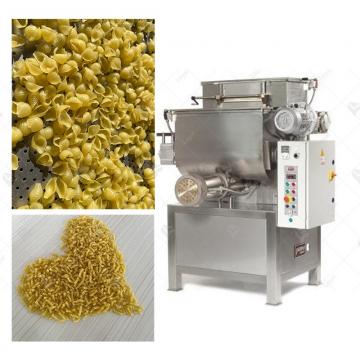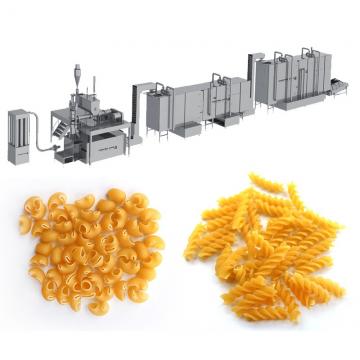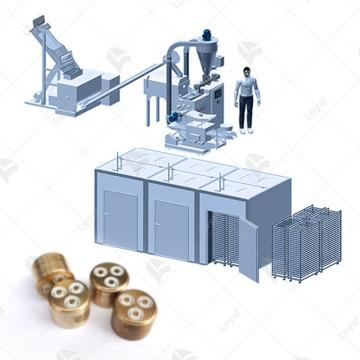Fully Automated Shortcut for Manufacturing: Streamlining Pasta Production with High Efficiency and Energy Savings
Fully Automated Shortcut for Manufacturing: Streamlining Pasta Production with High Efficiency and Energy Savings
In the dynamic landscape of pasta manufacturing, the concept of a shortcut for manufacturing has emerged as a transformative force. As we explore the intricacies of fully automated processes, this article aims to shed light on how these innovations are streamlining pasta production, fostering high efficiency, and delivering substantial energy savings.Shandong Loyal Industrial Co., Ltd. has incorporated advanced technologies from BID and PDominioni in the production of its macaroni.

The Evolution of Pasta Manufacturing Processes
Pasta production has evolved significantly, transitioning from traditional methods to embrace modern innovations. The historical backdrop provides insights into the roots of pasta manufacturing, leading us to the revolutionary era of fully automated processes. This evolution sets the stage for understanding the significance of the shortcut for manufacturing in enhancing the efficiency of pasta production.
Streamlining Pasta Production Through Full Automation
Delving into the heart of the matter, full automation in pasta manufacturing is a game-changer. We explore the components and features of fully automated systems, emphasizing their role in streamlining the entire production process. The benefits of high efficiency and energy savings become apparent, showcasing the practical implications of adopting this shortcut for manufacturing in the pasta industry.
Implementing the Shortcut for Manufacturing in Pasta Production
Real-world applications come to the forefront as we examine how leading pasta manufacturers such as Barilla, De Cecco, Creamette, San Giorgio, Great Value, and Ronzoni are actively implementing the shortcut for manufacturing. Case studies reveal tangible examples of efficiency gains and energy savings, providing a roadmap for others in the industry to follow suit.
Future Outlook: Advancements in Fully Automated Pasta Production
The future holds exciting possibilities as we explore emerging technologies in pasta manufacturing. Innovations on the horizon promise to redefine efficiency and sustainability. This section anticipates global impacts, industry adoption trends, and the evolving expectations of consumers in a world shaped by the shortcut for manufacturing.
Conclusion
In conclusion, the journey through fully automated pasta production showcases the transformative power of the shortcut for manufacturing. From historical roots to modern innovations, the industry has embraced efficiency and energy savings on an unprecedented scale. As Barilla, De Cecco, Creamette, San Giorgio, Great Value, and Ronzoni lead the way, the implications of this shortcut extend far beyond individual companies, shaping the future of pasta manufacturing.
From understanding the concept's roots to witnessing its practical applications by industry leaders, the article has showcased the significant impact of this innovative approach. As we anticipate future advancements, it's clear that the shortcut for manufacturing is not just a trend; it's a sustainable and efficient path shaping the future of pasta production.

FAQs: Frequently Asked Questions about Shortcut for Manufacturing
As we delve into the world of the shortcut for manufacturing in pasta production, it's crucial to address common queries that often arise. Let's unravel some of the frequently asked questions surrounding this innovative approach.
1. What defines the concept of a "shortcut for manufacturing" in pasta production?
The shortcut for manufacturing in pasta production refers to the strategic integration of fully automated processes to streamline the entire manufacturing workflow. This approach aims to enhance efficiency, reduce production time, and achieve substantial energy savings, marking a departure from traditional methods.
2. How do fully automated processes contribute to high efficiency in pasta production?
Fully automated processes in pasta production contribute to high efficiency by eliminating manual intervention, ensuring precision in every stage of manufacturing. Automated systems enhance consistency, reduce production errors, and significantly speed up the overall production process, resulting in increased efficiency.
3. Are there specific challenges associated with implementing the shortcut for manufacturing?
Implementing the shortcut for manufacturing may pose challenges such as initial investment costs and the need for staff training. However, these challenges are often outweighed by long-term benefits, including improved efficiency, energy savings, and enhanced product quality.
4. What role do leading pasta manufacturers like Barilla, De Cecco, and others play in adopting the shortcut for manufacturing?
Leading pasta manufacturers, including Barilla, De Cecco, Creamette, San Giorgio, Great Value, and Ronzoni, are pioneers in adopting the shortcut for manufacturing. Their proactive embrace of fully automated processes sets industry standards, showcasing the tangible benefits of this approach in terms of efficiency, quality, and sustainability.
5. What advancements can we expect in the future of fully automated pasta production?
The future of fully automated pasta production holds exciting possibilities, including advancements in artificial intelligence, data analytics, and sustainability initiatives. Predictive maintenance, adaptive processing, and further enhancements in energy efficiency are anticipated, paving the way for a new era of innovation in pasta manufacturing.





